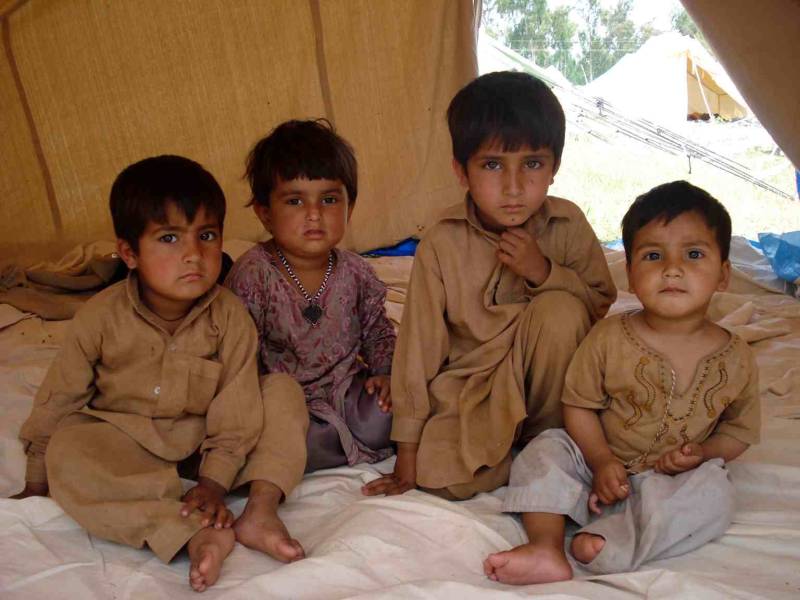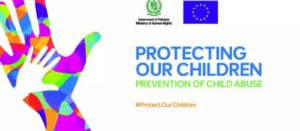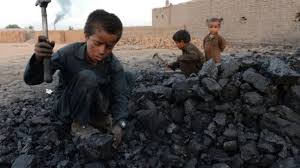
The roars against child domestic labor and murder flitted through the air, people from all corners of the country came forward courageously and swiftly to remind the state that Zohra Shah’s incident is not a first — with Shazia, Uzma, the list goes. Afshan Tahseen Bajwa, the chairperson of the newly established National Commission on the Rights of the Child (NCRC) in her official statement on the World Day against Child Labor this year emphasized her determination to resolve matters concerning the plight of children in domestic labor. She states, “as per the international treaties ratified by the Government of Pakistan, it is important to designate strict compliance, whereby the practice of child labor is eliminated”.
 NCRC in its 1st board meeting called on the representative of the office of Inspector General Police Punjab, Mr. Mohammad Faisal, SSP Investigation Rawalpindi for briefing the commission on the recent Zohra Shah Case. Besides apprising the legal and technical aspects of the case, Mr. Faisal also underlined poverty dynamics within, “when Zohra’s parents were contacted to come Rawalpindi for receiving the body of Zohra for burial, they did not have even little money to travel which was subsequently arranged by the Punjab police”. He further revealed it as a common practice in Punjab for “poor parents to send their children to unsafe homes as domestic workers for a small amount of money. I deal with such cases almost on daily basis.”
NCRC in its 1st board meeting called on the representative of the office of Inspector General Police Punjab, Mr. Mohammad Faisal, SSP Investigation Rawalpindi for briefing the commission on the recent Zohra Shah Case. Besides apprising the legal and technical aspects of the case, Mr. Faisal also underlined poverty dynamics within, “when Zohra’s parents were contacted to come Rawalpindi for receiving the body of Zohra for burial, they did not have even little money to travel which was subsequently arranged by the Punjab police”. He further revealed it as a common practice in Punjab for “poor parents to send their children to unsafe homes as domestic workers for a small amount of money. I deal with such cases almost on daily basis.”
In numerous articles published after Zohra’s case, child rights activists and authors poured their hearts out while penning down the facts and issues related to child labour in Pakistan. Obsolete data on child labor indicators, unresponsive and desensitized attitudes of communities towards child labor, lack of coherence in provincial and federal laws, loopholes within the legislative system particularly the issue of varying legal age and segregating child domestic labour as a hazardous occupation are those bitter realities which keep the status quo.

Rather than sending them to school, parents pushing children into child labor blatantly challenges progress for implementation of the Sustainable Development Goals (SDGs). Indicators of health, education, welfare and protection of children living in Pakistan are far below the requirement for meeting the SDGs.
According to the United Nations Report on State of the World’s Children (2019), “409,000 under-five-year-old deaths were recorded in Pakistan in 2018”. Though Pakistan was the sixth in the world to sign and ratify the Convention on the Rights of the Child, many children in Pakistan continue to suffer from discrimination, economic exploitation, neglect, physical and sexual abuse.
The outbreak of COVID 19 has alerted the state further to address the lethal nexus of poverty and pandemic since COVID-19 has exacerbated conditions for poverty due to negatively affecting the production networks in both agricultural and industrial sectors. The pandemic has had a drastic impact on the livelihoods and the socio-economic activities of the poor since they frequently engage in work that earn little capital, and are more likely to be exposed to the virus in these settings. The increase in poverty due to pandemic has put children at greater risk. The United Nations has declared that “there are three main ways children are affected by this crisis: infection with the virus itself; immediate socio-economic impacts of measures designed to stop transmission of the virus; and longer-term effects of delayed implementation of the Sustainable Development Goals."
 The impact of COVID-19 on children’s survival, well-being, and safety is deleterious in Pakistan. The lock-downs not only reduced the expected income of the families but fears about job stability have become a major reason of stress in families which has severe impact on children in particular. Challenges like unavailability of regular vaccination, undernourishment, capacity of poor in applying social distancing in a reduced space, and often of sub-housing have changed the routine habits of childhood. Furthermore, it can generate tensions, affecting their emotional state, engendering apathy, increasing domestic violence against children and mothers, and uncertainty or depression in childhood.
The impact of COVID-19 on children’s survival, well-being, and safety is deleterious in Pakistan. The lock-downs not only reduced the expected income of the families but fears about job stability have become a major reason of stress in families which has severe impact on children in particular. Challenges like unavailability of regular vaccination, undernourishment, capacity of poor in applying social distancing in a reduced space, and often of sub-housing have changed the routine habits of childhood. Furthermore, it can generate tensions, affecting their emotional state, engendering apathy, increasing domestic violence against children and mothers, and uncertainty or depression in childhood.
The head of the World Health Organization has warned the world about the impact of the disruption of normal health services, especially on children while quoting the findings of GAVI global vaccine alliance which shows that border restrictions due to the pandemic have caused shortage of vaccines against various diseases in 21 countries including Pakistan.
In the NCRC board meeting, the child member, Tajdar Qureshi Hashmi analysed the government’s policies and programs to deal pandemic from a child’s perspective and said, “there are number of difficulties in online classes. The area where I live, internet is very slow and top of that many students neither have access to the internet nor to IT equipment”. The other child member NCRC, Faryal Javed lamented: “our life is very grim; we have no friends to talk with, no school to walk in, and no grounds to play on. Our parents even do not allow us to talk to friends on phone for longer time. It makes us stressed. We require a special attention from parents.” While discussing the impact of COVID-19 on children, Chairperson NCRC emphasized the adequate provision of budgetary allocation for the improvement of the socio-economic condition of children. Muhammad Hassan Mangi, Director General, Federal Ministry of Human Rights (MoHR), highlighted that we believe in including children-voices in formulating child-related legislation, policies and programmes. He noted this step to be in accordance with the international standards.
The challenges of poverty and pandemic can be classified broadly into two groups: (1) the technical challenges which identify the role of state in ensuring the respect, protection and promotion of child rights in COVID-19 national emergency into their national legal systems in compliance with international human rights instruments; and (2) the adaptive challenges which recognize the role of society in community organization to safeguard children from COVID-19 through encouraging communities to learn new behaviors, change attitudes or beliefs. It requires multi-pronged set of actions during and after the pandemic to meet all these technical and adaptive challenges related to COVID-19.
First and of utmost importance is to enhance capacities of communities through employing adaptable policies and building resilience to increase awareness on COVID-19 prevention and response that emphasizes the rights of children.
Second, it is vital to increase child focused collaborative initiatives at local and national levels that strengthen inclusive communities beyond COVID-19 to address the issue of child labour more responsibly and pragmatically.
Third, the state needs to allocate sufficient budget while dealing with the myth that cases of COVID-19 appear to be fewer among children (and symptoms generally milder). The national responses to the pandemic is not child-specific, children deserve special attention. Besides ensuring access to education, the state has to ensure the provision of health and nutrition packages to children.
Finally, the state should revisit its national emergency programmes and coordinate with UN agencies to ensure that the poor may survive the pandemic when their health and livelihood is deteriorating.
 NCRC in its 1st board meeting called on the representative of the office of Inspector General Police Punjab, Mr. Mohammad Faisal, SSP Investigation Rawalpindi for briefing the commission on the recent Zohra Shah Case. Besides apprising the legal and technical aspects of the case, Mr. Faisal also underlined poverty dynamics within, “when Zohra’s parents were contacted to come Rawalpindi for receiving the body of Zohra for burial, they did not have even little money to travel which was subsequently arranged by the Punjab police”. He further revealed it as a common practice in Punjab for “poor parents to send their children to unsafe homes as domestic workers for a small amount of money. I deal with such cases almost on daily basis.”
NCRC in its 1st board meeting called on the representative of the office of Inspector General Police Punjab, Mr. Mohammad Faisal, SSP Investigation Rawalpindi for briefing the commission on the recent Zohra Shah Case. Besides apprising the legal and technical aspects of the case, Mr. Faisal also underlined poverty dynamics within, “when Zohra’s parents were contacted to come Rawalpindi for receiving the body of Zohra for burial, they did not have even little money to travel which was subsequently arranged by the Punjab police”. He further revealed it as a common practice in Punjab for “poor parents to send their children to unsafe homes as domestic workers for a small amount of money. I deal with such cases almost on daily basis.”In numerous articles published after Zohra’s case, child rights activists and authors poured their hearts out while penning down the facts and issues related to child labour in Pakistan. Obsolete data on child labor indicators, unresponsive and desensitized attitudes of communities towards child labor, lack of coherence in provincial and federal laws, loopholes within the legislative system particularly the issue of varying legal age and segregating child domestic labour as a hazardous occupation are those bitter realities which keep the status quo.

Rather than sending them to school, parents pushing children into child labor blatantly challenges progress for implementation of the Sustainable Development Goals (SDGs). Indicators of health, education, welfare and protection of children living in Pakistan are far below the requirement for meeting the SDGs.
According to the United Nations Report on State of the World’s Children (2019), “409,000 under-five-year-old deaths were recorded in Pakistan in 2018”. Though Pakistan was the sixth in the world to sign and ratify the Convention on the Rights of the Child, many children in Pakistan continue to suffer from discrimination, economic exploitation, neglect, physical and sexual abuse.
The outbreak of COVID 19 has alerted the state further to address the lethal nexus of poverty and pandemic since COVID-19 has exacerbated conditions for poverty due to negatively affecting the production networks in both agricultural and industrial sectors. The pandemic has had a drastic impact on the livelihoods and the socio-economic activities of the poor since they frequently engage in work that earn little capital, and are more likely to be exposed to the virus in these settings. The increase in poverty due to pandemic has put children at greater risk. The United Nations has declared that “there are three main ways children are affected by this crisis: infection with the virus itself; immediate socio-economic impacts of measures designed to stop transmission of the virus; and longer-term effects of delayed implementation of the Sustainable Development Goals."
 The impact of COVID-19 on children’s survival, well-being, and safety is deleterious in Pakistan. The lock-downs not only reduced the expected income of the families but fears about job stability have become a major reason of stress in families which has severe impact on children in particular. Challenges like unavailability of regular vaccination, undernourishment, capacity of poor in applying social distancing in a reduced space, and often of sub-housing have changed the routine habits of childhood. Furthermore, it can generate tensions, affecting their emotional state, engendering apathy, increasing domestic violence against children and mothers, and uncertainty or depression in childhood.
The impact of COVID-19 on children’s survival, well-being, and safety is deleterious in Pakistan. The lock-downs not only reduced the expected income of the families but fears about job stability have become a major reason of stress in families which has severe impact on children in particular. Challenges like unavailability of regular vaccination, undernourishment, capacity of poor in applying social distancing in a reduced space, and often of sub-housing have changed the routine habits of childhood. Furthermore, it can generate tensions, affecting their emotional state, engendering apathy, increasing domestic violence against children and mothers, and uncertainty or depression in childhood.The head of the World Health Organization has warned the world about the impact of the disruption of normal health services, especially on children while quoting the findings of GAVI global vaccine alliance which shows that border restrictions due to the pandemic have caused shortage of vaccines against various diseases in 21 countries including Pakistan.
In the NCRC board meeting, the child member, Tajdar Qureshi Hashmi analysed the government’s policies and programs to deal pandemic from a child’s perspective and said, “there are number of difficulties in online classes. The area where I live, internet is very slow and top of that many students neither have access to the internet nor to IT equipment”. The other child member NCRC, Faryal Javed lamented: “our life is very grim; we have no friends to talk with, no school to walk in, and no grounds to play on. Our parents even do not allow us to talk to friends on phone for longer time. It makes us stressed. We require a special attention from parents.” While discussing the impact of COVID-19 on children, Chairperson NCRC emphasized the adequate provision of budgetary allocation for the improvement of the socio-economic condition of children. Muhammad Hassan Mangi, Director General, Federal Ministry of Human Rights (MoHR), highlighted that we believe in including children-voices in formulating child-related legislation, policies and programmes. He noted this step to be in accordance with the international standards.
The challenges of poverty and pandemic can be classified broadly into two groups: (1) the technical challenges which identify the role of state in ensuring the respect, protection and promotion of child rights in COVID-19 national emergency into their national legal systems in compliance with international human rights instruments; and (2) the adaptive challenges which recognize the role of society in community organization to safeguard children from COVID-19 through encouraging communities to learn new behaviors, change attitudes or beliefs. It requires multi-pronged set of actions during and after the pandemic to meet all these technical and adaptive challenges related to COVID-19.
First and of utmost importance is to enhance capacities of communities through employing adaptable policies and building resilience to increase awareness on COVID-19 prevention and response that emphasizes the rights of children.
Second, it is vital to increase child focused collaborative initiatives at local and national levels that strengthen inclusive communities beyond COVID-19 to address the issue of child labour more responsibly and pragmatically.
Third, the state needs to allocate sufficient budget while dealing with the myth that cases of COVID-19 appear to be fewer among children (and symptoms generally milder). The national responses to the pandemic is not child-specific, children deserve special attention. Besides ensuring access to education, the state has to ensure the provision of health and nutrition packages to children.
Finally, the state should revisit its national emergency programmes and coordinate with UN agencies to ensure that the poor may survive the pandemic when their health and livelihood is deteriorating.
